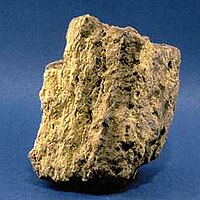
Photo from wikipedia
The newly discovered Baogudi gold district is located in the southwestern Guizhou Province, China, where there are numerous Carlin-type gold deposits. To better understand the geological and geochemical characteristics of… Click to show full abstract
The newly discovered Baogudi gold district is located in the southwestern Guizhou Province, China, where there are numerous Carlin-type gold deposits. To better understand the geological and geochemical characteristics of the Baogudi gold district, we carried out petrographic observations, elemental analyses, and fluid inclusion and isotopic composition studies. We also compared the results with those of typical Carlin-type gold deposits in southwestern Guizhou. Three mineralization stages, namely, the sedimentation diagenesis, hydrothermal (main-ore and late-ore substages), and supergene stages, were identified based on field and petrographic observations. The main-ore and late-ore stages correspond to Au and Sb mineralization, respectively, which are similar to typical Carlin-type mineralization. The mass transfer associated with alteration and mineralization shows that a significant amount of Au, As, Sb, Hg, Tl, Mo, and S were added to mineralized rocks during the main-ore stage. Remarkably, arsenic, Sb, and S were added to the mineralized rocks during the late-ore stage. Element migration indicates that the sulfidation process was responsible for ore formation. Four types of fluid inclusions were identified in ore-related quartz and fluorite. The main-ore stage fluids are characterized by an H2O–NaCl–CO2–CH4 ± N2 system, with medium to low temperatures (180–260 °C) and low salinity (0–9.08% NaCl equivalent). The late-ore stage fluids featured H2O–NaCl ± CO2 ± CH4, with low temperature (120–200 °C) and low salinity (0–7.48% NaCl equivalent). The temperature, salinity, and CO2 and CH4 concentrations of ore-forming fluids decreased from the main-ore stage to the late-ore stage. The calculated δ13C, δD, and δ18O values of the ore-forming fluids range from − 14.3 to − 7.0‰, −76 to −55.7‰, and 4.5–15.0‰, respectively. Late-ore-stage stibnite had δ34S values ranging from − 0.6 to 1.9‰. These stable isotopic compositions indicate that the ore-forming fluids originated mainly from deep magmatic hydrothermal fluids, with minor contributions from strata. Collectively, the Baogudi metallogenic district has geological and geochemical characteristics that are typical of Carlin-type gold deposits in southwest Guizhou. It is likely that the Baogudi gold district, together with other Carlin-type gold deposits in southwestern Guizhou, was formed in response to a single widespread metallogenic event.
Journal Title: Acta Geochimica
Year Published: 2019
Link to full text (if available)
Share on Social Media: Sign Up to like & get
recommendations!